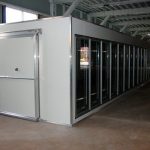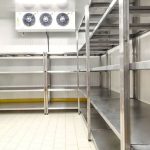The Importance of Proper Door Sealing for Coolrooms and Freezers
- 20 October 2015
Manufacturers are responsible for building walk-in freezers to exacting standards, specifications that typically zero in on energy savings and modern features. Product owners then follow their instruction manuals, reinforcing the prowess of a glacially cooled freezer by initiating sound loading policies. Unfortunately, even the best cooling appliances are only as good as their weakest link. Adequate door sealing for coolrooms and freezers prevents an entryway from becoming this system Achilles heel.
Keeping Cold Air In and Warm Air Out
The layout of a specialized cooling chamber is fairly consistent from one design to the next. Insulated panels stop thermal losses. A ventilation system, drainage apparatus, and a refrigeration unit form the core of the system, maintaining the frosty environment. It’s an efficient arrangement, except for one glaring weak spot; a portal is open to the outside, an entryway that allows staff access to the interior. This man-sized opening cuts into one of the walls and introduces a necessary but potentially costly design flaw. The solution to the issue is to fit a door and a hefty locking mechanism, a lever and clasp design that presses against a rubberised gasket. The partnership created by the door and its tightly stoppered gasket is a seal that prevents energy losses.
Door Seal Designs are Born of Extrusion Technology
Extruded rubber and soft plastics form the best barriers. Door Sealing for coolrooms and freezers benefit from this approach because the rubber will conform to any of the eccentric outlines and contours set in the door frame and thus form an airtight perimeter that surrounds the entire door. The effect is immediate, a rejection of ambient outside air and the maximization of environmental mastery within the confines of the cold room. The extruded profile of this rubber product once assumed a simple tubular shape, but many innovative forms of the product now exist. Additionally, hinged doors and sliding doors introduce different stress characteristics to the gasket. The fixtures must take account of these detrimental influences and imbue the product with mechanical strength. A poorly manufactured gasket would crack and leak warm air into the chamber within a few months of enthusiastic door closing, but a product fabricated from a high-quality rubber will absorb the brunt of every close/open cycle without weakening.
It’s only common sense, the installation of a robust door and an airtight seal. These leak-resistant fixtures stop energy losses, prevent refrigeration units aging prematurely, and place the savings in the owner’s wallet. It’s also recommended that the equipment and its fixtures be maintained periodically, as door sealing for coolrooms and freezers can experience mechanical damage and a weakening effect, one that’s caused by temperature spikes. Opt for the best possible gasket materials and avoid the bulk of these problems.
Mark Connelly
C&M Coolroom Services
E-mail : markconnelly@cmcoolrooms.com.au
Mobile: 0412 536 315


